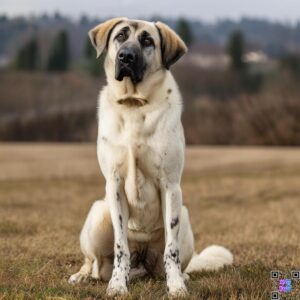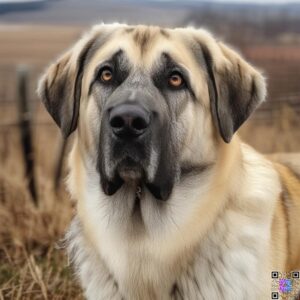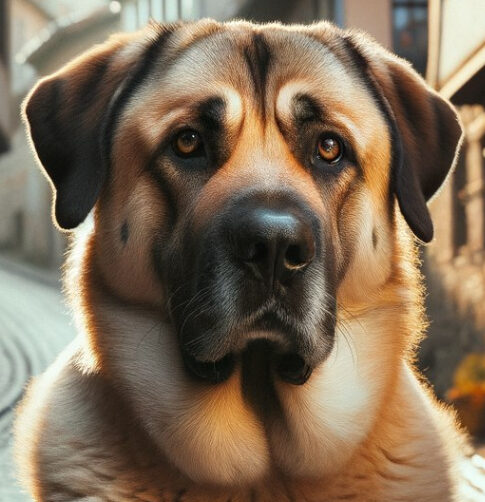Introduction
The merle Anatolian Shepherd is a remarkable breed that combines beauty with strength and loyalty. Known for its unique coat pattern and protective instincts, this dog has a fascinating history and a variety of characteristics that make it a beloved companion for many. Whether you’re considering adding one to your family or simply want to learn more about this captivating breed, this article will provide you with all the insights you need. You will get every detail about Merle Anatolian Shephered in this article.
Understanding the Merle Anatolian Shepherd

The merle Anatolian Shepherd is a variation of the Anatolian Shepherd Dog, distinguished by its striking coat pattern. This breed has its roots in Turkey, where it was primarily bred as a livestock guardian. The merle pattern, characterized by irregular patches of color, adds to the breed’s allure. However, it’s essential to understand that the merle coat is not just about aesthetics; it carries implications for the dog’s health and breeding practices. Anatolian Shepherds are known for their independence and strong protective instincts. They are large dogs, typically weighing between 80 to 150 pounds, and they possess a powerful build that allows them to guard livestock effectively. The merle pattern can appear in various shades, often accompanied by blue or partially blue eyes, which further enhances their striking appearance.
History of the Anatolian Shepherd Dog
The history of the merle Anatolian Shepherd is intertwined with the development of the Anatolian Shepherd Dog itself. This breed dates back over 6,000 years, originating in the Anatolia region of Turkey. Historically, these dogs were bred by nomadic tribes to protect their flocks of sheep and goats from predators.
Their ability to work independently and make decisions about threats made them invaluable companions to shepherds. The Anatolian Shepherd was introduced to the United States in the late 1930s, but it wasn’t until the 1970s that the breed gained popularity. The U.S. Department of Agriculture recognized the need for effective livestock guardians, leading to the importation of more Anatolian Shepherds. The breed was officially recognized by the American Kennel Club in 1996, marking a significant milestone in its history.
Characteristics of the Merle Anatolian Shepherd
The merle Anatolian Shepherd is not only known for its unique coat but also for its impressive characteristics. These dogs are highly intelligent, loyal, and protective. They have a calm demeanor but can be wary of strangers, making them excellent guardians. Their size and strength allow them to deter potential threats, while their agility enables them to respond quickly to any danger. In terms of temperament, Anatolian Shepherds are independent thinkers. This trait can make training a challenge, but with consistent and positive reinforcement, they can learn commands and behaviors effectively. Early socialization is crucial to ensure they grow up to be well-adjusted dogs that can interact positively with people and other animals.
The Merle Coat Pattern The merle coat pattern in dogs is a fascinating subject. It results from a genetic mutation that causes irregular patches of color on a lighter background. In the merle Anatolian Shepherd, this pattern can manifest in various shades, often adding to the dog’s visual appeal. However, it’s important to note that breeding merle dogs can lead to health issues, particularly if two merle dogs are bred together.
This practice can increase the likelihood of producing double-merle dogs, which may suffer from serious health problems such as deafness or vision impairment. Responsible breeding practices are essential to ensure the health and well-being of merle Anatolian Shepherds. Breeders should prioritize health and temperament over coat color, focusing on producing dogs that are not only beautiful but also healthy and capable of fulfilling their roles as guardians.
Training and Socialization
Training a merle Anatolian Shepherd requires patience and consistency. These dogs are known for their independent nature, which can lead to challenges in obedience training. Starting training at an early age is crucial, as it helps establish a strong bond between the dog and its owner. Positive reinforcement techniques, such as treats and praise, work best with this breed. Socialization is equally important. Exposing your merle Anatolian Shepherd to various environments, people, and animals will help them develop confidence and reduce their natural wariness of strangers. Regular interactions with different stimuli will ensure they become well-rounded and adaptable dogs, capable of handling various situations with ease.
Health Considerations
Like all breeds, the merle Anatolian Shepherd is prone to certain health issues. While the merle coat itself does not directly cause health problems, the genetics associated with it can lead to complications if not managed properly. For instance, double-merle dogs are at a higher risk for deafness and vision issues. Therefore, it is crucial for potential owners to work with reputable breeders who conduct health screenings and prioritize the overall well-being of their dogs. Regular veterinary check-ups, a balanced diet, and proper exercise are essential for maintaining the health of your merle Anatolian Shepherd. Being proactive about their health can help prevent many common issues and ensure they lead long, fulfilling lives.
Merle Anatolian Shepherd as a Family Pet
The merle Anatolian Shepherd can make a wonderful family pet, but it’s essential to consider their unique needs. These dogs thrive in environments where they have space to roam and a job to do. They are best suited for families with a large yard or rural settings where they can exercise and fulfill their protective instincts. While they can be affectionate with their families, they may not be overly cuddly. Their loyalty and protective nature mean they will bond closely with their family members, often taking on a guardian role. Early socialization and training will help them learn to interact positively with children and other pets in the household.
Temperament and Behavior
- General Temperament of Anatolian Shepherds: Known for their protective nature, these dogs are highly loyal to their families. They are intelligent and independent thinkers but require consistent training from an early age.
- Unique Traits of the Merle Variant: While all Anatolian Shepherds share similar temperamental traits, some owners report that merles can be slightly more energetic or playful compared to their solid-colored counterparts.
- Socialization Needs: Proper socialization is crucial for any dog but especially for working breeds like the Merle Anatolian Shepherd, as they need exposure to various environments and people to develop into well-rounded pets.
Training and Care
- Basic Training Techniques: Positive reinforcement methods work best with this breed. Early obedience training is essential to ensure they understand commands and boundaries.
- Grooming Requirements: The short coat of the merle variant requires minimal grooming; however, regular brushing helps reduce shedding and keeps their coat healthy.
- Health Considerations: Like all breeds, they are prone to specific health issues such as hip dysplasia or certain genetic conditions. Regular veterinary check-ups are vital for maintaining their health.
The Role of the Merle Anatolian Shepherd Today
- Working Dog Capabilities: These dogs excel in roles such as livestock guardianship due to their protective instincts and intelligence. They are also used in search-and-rescue operations due to their keen sense of smell.
- Popularity as a Family Pet: Increasingly recognized as excellent family pets, the Merle Anatolian Shepherds combine loyalty with a playful spirit that endears them to families looking for both protection and companionship.
Common Myths and Misconceptions
- Myths About the Merle Coat: Some believe that merled coats indicate poor health or temperament; however, this is not true. The coat color does not affect their abilities or behavior negatively.
- Misunderstandings About Behavior: There’s a misconception that these dogs are aggressive; however, when properly trained and socialized, they can be gentle giants who thrive in family settings.
Caring for Your Merle Anatolian Shepherd
Caring for a merle Anatolian Shepherd involves meeting their physical, mental, and emotional needs. Regular exercise is crucial, as these dogs have high energy levels and require daily physical activity. Activities such as long walks, playtime, and training sessions will help keep them mentally stimulated and physically fit. Grooming is relatively straightforward, as their short coat requires minimal maintenance. Regular brushing will help reduce shedding and keep their coat healthy. Additionally, routine veterinary care, including vaccinations and dental check-ups, is essential for their overall health.

Frequently Asked Questions
1- What is a merle Anatolian Shepherd?
A merle Anatolian Shepherd is a variation of the Anatolian Shepherd Dog characterized by a unique coat pattern that features irregular patches of color.
2- Are merle Anatolian Shepherds good family pets?
Yes, merle Anatolian Shepherds can be excellent family pets, especially in homes with ample space and active lifestyles.
3- What health issues are associated with merle Anatolian Shepherds?
While the merle coat itself does not cause health issues, breeding practices can lead to problems such as deafness and vision impairment, particularly in double-merle dogs.
4- How much exercise do merle Anatolian Shepherds need?
Merle Anatolian Shepherds require regular exercise, including daily walks and playtime, to keep them physically and mentally stimulated.
5- Can merle Anatolian Shepherds be trained easily?
Training a merle Anatolian Shepherd can be challenging due to their independent nature, but with consistent positive reinforcement, they can learn effectively.
6- What should I consider before getting a merle Anatolian Shepherd?-
Before getting a merle Anatolian Shepherd, consider their exercise needs, space requirements, and the importance of early socialization and training.
Conclusion
The merle Anatolian Shepherd is a unique and captivating breed that brings together beauty, strength, and loyalty. With a rich history and distinct characteristics, these dogs make excellent guardians and companions. Understanding their needs and health considerations is crucial for potential owners. By providing proper training, socialization, and care, you can ensure that your merle Anatolian Shepherd thrives as a beloved member of your family.
In conclusion, the Merle Anatolian Shepherd is more than just a visually stunning dog; it embodies loyalty, intelligence, and strength. With roots deeply embedded in history as protectors of livestock, these dogs have adapted beautifully into modern family life without losing their working instincts. Whether you’re considering adopting one or simply want to learn more about this incredible breed, understanding its characteristics will help you appreciate what makes it truly special. As we continue to explore our connection with animals like the Merle Anatolian Shepherd, we uncover not only their value but also our shared journey through companionship.
